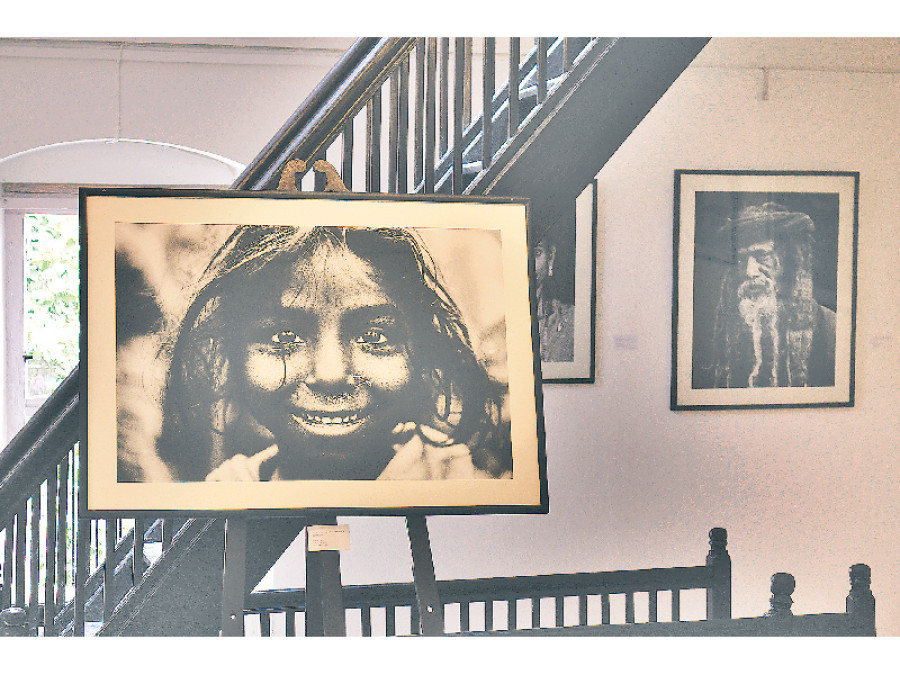Miscellaneous
Nepal in Monochrome
Hundred-year-old Namgyal Dolma’s face tells many stories. The lines on her face—seen on a black-and-white portrait photograph of her, currently ondisplay at the Siddhartha Art Gallery, Babermahal—tell tales of lost identity, of struggle and survival.
Nhooja Tuladhar
Hundred-year-old Namgyal Dolma’s face tells many stories. The lines on her face—seen on a black-and-white portrait photograph of her, currently on
display at the Siddhartha Art Gallery, Babermahal—tell tales of lost identity, of struggle and survival.
The photograph of the senior Tibetan refugee is one among a
collection of 46 photographs by Jan Moller Hansen, a Danish photographer and diplomat currently based in Nepal. The caption next to the photograph tells the viewers how Dolma has been living in a refugee camp here in Kathmandu since 1960. In fact, four generations of her family currently live in the same camp.
Like Dolma’s portrait, the other works in Images of Nepal, too, tell stories of people—mostly of Nepalis and of some who have been living here as refugees—who have been working hard to live their days in an underdeveloped world.
Upon entering the gallery ground floor, the viewer is greeted by a series of black-and-white photographs, of which the smallest is about 15X23 inches. These photographs are predominantly portraits, spare some that depict urban Nepali landscape, earthquake ravaged areas, and so forth.
Hansen’s collection—although deprived of any strict markings or divisions—is divided into sections. The sections, it seems, has been based on the socio-political similarities that the content of the photographs carries. The series, because it comes out of the photographer’s travels around Nepal, has also been divided, in some places, according to the areas where the photographer has journeyed to capture the frames.
The ground floor primarily displays portraits of refugees in Nepal—Tibetans, Bhutanese and Burmese (the Myanmar people are referred to as “illegal refugees” in Hansen’s captions)—and child workers. In the collection, Hansen’s captions provide context to most photographs. And since most of the photographs are postcard-like portraits, it would be difficult for the viewer to make much of them otherwise. Some of the captions work quite well: for example, in a portrait of two girls, the caption reads: “Two girls who work at a brick kiln in Tathali [Bhaktapur District]. Migration caused by rural poverty, lack of opportunities and a ten-year long insurgency has made efforts to reduce child labor more difficult.” Two teenage girls are photographed here against the backdrop of a roughly plastered brick wall. They look right through the glass frame they are in and stare back at you. The girl on the left has her arms around the other girl.
But not all captions do justice to the photographs. The twelfth photograph from the collection, for example, is a mug-shot of a boy. His hair is messy and there are dirt stains on his face. The boy has a smile on his face—his face is focused, the rest of it is blurred. The caption reads: “A Dalit boy in Simikot, Humla.” Of course, the six words does somewhat provide the viewer with the location and the situation of the photographer’s subject, but the image makes the same kind of impact without it. It feels like the photograph is just one among the many portraits that Hansen took during his travels around the country. It is commendable for a man of Hansen’s stature to be going around and interacting with people first-hand and hence, in my opinion, photos such as this would do well without a caption rather than with one.
Hansen’s way with his media is praiseworthy. Because all the photos are shot in monochrome, the images are spared from hue contrasts that could—when working in a non-setup environment—distract the viewer’s eyes. Instead they are exposed to gradients that shift from whites to grays to black, and back to grays. This and the sharp and blur textures work as separators of subjects. The depth of field, the photographer has exploited masterfully, guides the audiences’ eyes to move around the canvas. The photographs are printed on Hahnemuehle paper using Archival Ink.
Hansen’s book, also titled Images of Nepal, was also launched during the inaugural ceremony of the photography exhibition on September 9. The book also consists of Hansen’s controversial photography, titled Mother Saying Goodbye to her Angel, which depicts family members trying to console a mother who has just lost her child, in Aryaghat, Pashupati. The body of the child rests on a flat stone, his feet slightly touching Bagmati’s waters. The photograph had received much criticism when it was published along with an article titled Societies in Black and White written by Kunda Dixit last year. One nepalikukur has commented: “Unfortunately, the photo that won Hansen an award [the photographer won 1x.com‘s 2013 Photo Award on Documentary (People’s Choice)] is probably one he should not have taken or published. A powerful image, no doubt, but without consent (one assumes) nor the imperative of reportage (e.g. conflict), this is mere voyeurism.”
Judging by the place where the photograph was taken, it seems Hansen had captured the image from the opposite bank of the Bagmati River, a good 30 metres—give or take—away from where the child’s final rites were being held—and probably out of the family members’ view. Considering this, the picture of Hansen’s does come out to be voyeuristic and unethical as there has not been any evidence, yet, about the family being aware of the photographer taking the picture.
Nevertheless, the images currently being displayed in the gallery refrain from such issues and is of the nature that immediately garners positive attention. Hansen has to be thanked for being a foreign official who takes time out to understand Nepal not just superficially, but by actually interacting with its people.




 19.12°C Kathmandu
19.12°C Kathmandu








%20(1).jpg&w=300&height=200)

